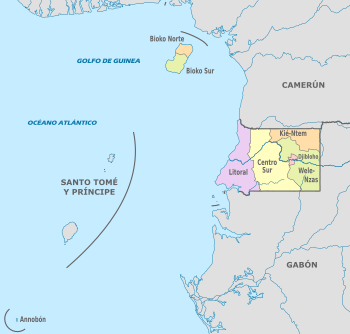Subdivisions of Equatorial Guinea facts for kids
Equatorial Guinea is a country in Africa. Like many countries, it is divided into smaller parts to help manage it better. Think of it like how your country might have states, provinces, or counties. Equatorial Guinea uses regions, provinces, districts, and municipalities to organize itself.
The main way the country is divided is into provinces. These are the biggest parts after the regions. Inside these provinces, there are smaller areas called districts and even smaller ones called municipalities. There are also very local groups called village councils in the countryside and neighborhood communities in cities.
Contents
Regions of Equatorial Guinea
Equatorial Guinea has two main parts, or regions:
- The Continental Region is called Río Muni. This is the part of the country that is on the mainland of Africa.
- The Insular Region is made up of islands. The biggest islands are Bioko and Annobón. There are also smaller islands like Corisco, Elobey Grande, and Elobey Chico.
Some of the very small islands, like Mbañe, Conga, and Cocotero, are currently part of a disagreement with the country of Gabon. Both countries believe these islands belong to them. This issue is being looked at by an international court.
Provinces of Equatorial Guinea
Equatorial Guinea is divided into eight main areas called provinces. Each province has a capital city where its government is located.

Here are the eight provinces and their capital cities:
- Annobón (Capital: San Antonio de Palé)
- Bioko Norte (Capital: Malabo)
- Bioko Sur (Capital: Luba)
- Centro Sur (Capital: Evinayong)
- Djibloho (Capital: Ciudad de la Paz)
- Kié-Ntem (Capital: Ebebiyín)
- Litoral (Capital: Bata)
- Wele-Nzas (Capital: Mongomo)
These provinces are then divided into 19 districts and 37 municipalities.
Districts and Municipalities
Inside each province, there are smaller areas called districts. And within each district, you'll find even smaller areas called municipalities. A municipality usually includes a main town or city and the areas around it.
For example, the province of Bioko Norte has two districts: Malabo and Baney. The Malabo district includes the municipality of Malabo, which is also the capital of the province. The Baney district includes the municipalities of Baney and Rebola. This system helps organize local services and government.
Local Government Groups
Below the municipalities, there are even smaller groups that help manage local areas.
- In rural areas (the countryside), these are called village councils (consejos de poblados).
- In urban areas (cities), they are called neighbourhood communities (comunidades de vecinos).
In 2013, there were over 700 village councils and more than 300 neighbourhood communities across Equatorial Guinea.
In big cities like Malabo and Bata, neighbourhood communities are grouped into urban districts. These urban districts help organize the city even further. They are part of the municipality, not the larger districts we talked about earlier. In 2017, more urban districts were created, bringing the total to 65 across the country.
See also
 In Spanish: Organización territorial de Guinea Ecuatorial para niños
In Spanish: Organización territorial de Guinea Ecuatorial para niños
- List of cities in Equatorial Guinea
- Municipalities of Equatorial Guinea
- Provinces of Equatorial Guinea

